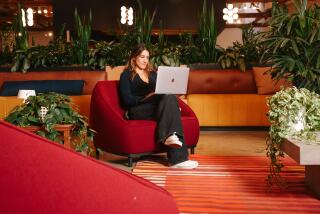Comfort in Work Area Means More Productive Worker
- Share via
WASHINGTON — What a difference a decent work space makes. A desk with plenty of room to spread out. A chair that offers the perfect posture. The right light and a comfortable computer keyboard. “Walls” that offer some privacy, but also make it easy to work with others.
That may sound like the dream office for some workers who come into a dreary cubicle every morning and leave every night with an aching back and a pile of undone work. But increasingly, as companies pay more attention to how office space is designed and furnished, workers are finding their environments more suited to their individual jobs and certainly more comfortable.
When this tough fit between form and function is achieved, companies often find that a comfortable worker, who can do a job with a minimum of distractions, obstructions, clutter and annoyance, is a more productive, happier worker.
Though it is no small feat to accurately measure and interpret how the work environment affects productivity, companies that take a stab at it--usually with the help of professionals such as industrial psychologists--have come up with some startling conclusions.
Aetna Life & Casualty has been studying this question over the past decade and more recently looked at how the productivity of its workers was affected by a six-year, $100-million renovation of its home office complex in Hartford,Conn.--1.6 million square feet of working space.
In that process, a jumble of metal desks, frayed carpeting and overflowing file cabinets in a “bullpen” was transformed into a space with neat workstations, ergonomic chairs, special task lighting, new carpeting, a sound-masking system and glare-filtering window shades.
Accessories such as document holders, palm rests, footrests and “articulating keyboard arms” to allow employees to adjust the position of computer keyboards also were included to enhance comfort and productivity.
Before the renovation, which was the largest interior redesign job in New England, 91% of the employees surveyed in a division representative of all of Aetna’s office workers complained that their personal work areas were crowded and it was difficult to do everyday work--such as organizing paper work, reading and writing.
Post-redesign, employees said changes such as the face lift have “had a positive effect on the volume, speed and accuracy of my work” and it “has given the whole unit a lift--an absolutely positive effect on performance.”
Throwing out old metal furniture and cleaning up the cluttered open space for new furniture even before the space was renovated resulted in a 67% increase in productivity and a 14% decrease in absenteeism. When employees moved with the new furniture into totally renovated digs, productivity leveled off but was 53% higher than in old-desk days.
“It’s important that your space say something about you and your company,” said Carol Sullivan, Aetna’s environmental psychologist. T.J. Springer, president of Springer Associates, an ergonomic consulting firm in St. Charles, Ill., also is a believer in performance improvements that are related to better work environments. For example, reduce glare on terminal screens for a 3% to 5% increase in performance. Put in good chairs, which Springer called “the foundation of the workplace,” and you get a 4% to 6% increase. Go with “appropriately adaptive furniture” that can be moved and adjusted, and productivity can go up to 24%.
More to Read
Inside the business of entertainment
The Wide Shot brings you news, analysis and insights on everything from streaming wars to production — and what it all means for the future.
You may occasionally receive promotional content from the Los Angeles Times.










